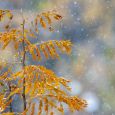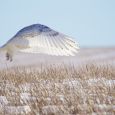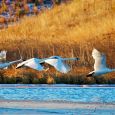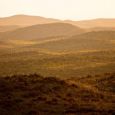The Gift of South Dakota
Subscriptions to South Dakota Magazine make great gifts!
Subscribe today — 1 year (6 issues) is just $29!
Becoming a Birder
South Dakota’s varied landscapes — the river valleys, mountains, badlands and glacial lakes — are a bird-watcher’s paradise.
 |
| Rebecca Johnson looks for a Pacific loon on Wall Lake just west of Sioux Falls. |
"Is this a practical joke?” I thought, staring intently through my binoculars. Doug Chapman, a veteran birdwatcher and my guide for the day, had stopped the car to point out a snipe near the road. Broken cornstalks and mud clumps were all I could see. I began to feel uneasy. Was this some type of hazing initiation for Sioux Falls Bird Club newcomers? I had heard of snipe hunting — the silliness of sending someone on an impossible task — but didn’t know anything about the bird.
Do snipes even exist? What color are they? How big? Am I being played for a sucker? A big sucker? Doubts like those fly through a novice’s mind when faced with a car-full of veteran birdwatchers who can tell a field sparrow from a song sparrow at 50 yards.
My companions were obviously waiting for me to remark on the invisible snipe. I adjusted my binoculars. With great relief I spotted two mud-colored birds poking their long slender bills into the dirt. And then I saw 30 more. Later I learned that snipe hunting is named after this bird that is difficult to shoot because of its erratic flight pattern.
Once I saw the snipe, I felt officially initiated into the world of birding – the fastest growing hobby in the United States. Sixty million people in the country now call themselves birders.
Why the popularity? “It’s a hobby that people can be involved in at nearly every level,” says K.C. Jensen, associate professor in South Dakota State University’s Department of Wildlife and Fisheries Sciences, “whether it is just watching birds out of their feeders at home or on trips to exotic places.” Jensen noted it is a great sport for those with handicaps and the elderly, but people of all ages and athletic abilities find excitement in spotting a rare bird.
South Dakota is a bird-watcher’s paradise because of our varied landscapes. Some species like the prairie river valleys, especially the muddy Missouri’s bordering forests. Others frequent our western mountains and badlands, and migratory waterfowl flock to the Glacial Lakes in the northeast. Favorite spots include Lacreek National Wildlife Refuge near Martin in southwest South Dakota and Sand Lake Refuge in the northeast, but grebes, loons, pelicans and hundreds of other species — including the very rare whooping crane — might be seen anywhere.
So, how does one get started in the sport? “All you need is a pair of binoculars and a bird guide book,” says Jensen. “You can get a very good pair of binoculars for $100 or less and a really good bird guide will cost you $15 to $20.”
 |
| Kingbirds are at home on the open prairie. Photo by Chad Coppess/ S.D. Tourism. |
Jensen also suggested that new birders find an experienced veteran to show him or her the ropes, so I called the Sioux Falls Bird Club and was invited to one of their monthly outings in the fall of 2010, which are open to the public. That’s how I met Chapman, and how I saw my first snipe.
We met on a cold, windy day at the South Dakota Game, Fish and Parks Outdoor Campus. I was armed with my husband’s hunting binoculars and a bird guide from the public library. We made introductions, split into small groups and then formed a caravan of cars. I was assigned to Chapman’s car along with Inez Orthmeyer and Mick Zerr – all of Sioux Falls. Chapman and Zerr have been interested in birds since childhood, but Orthmeyer considers herself a newbie. “I did a little of it when my son became a biologist but didn’t join the bird club until about 10 years ago, so I’m still a novice,” Orthmeyer said. Ten years and still a novice — what was I getting myself into?
Our first stop was to investigate a tip Zerr had received about a summer tanager frequenting a feeder at a suburban home. Chapman drove down Louise Avenue chatting about driving safety while bird watching. He briefly lost his train of thought when he spotted a bird flying over the mall parking lot. “What kind of a gull is that?” he exclaimed, slightly swerving to look.
We arrived at the home on the northwest side of town, parked and waited. “Bird watching takes patience,” says Chapman. “Sometimes it’s finely rewarded and sometimes unrewarded.”
We watched finches, sparrows and a woodpecker appear with little fanfare. I began to yawn. After about 30 minutes, the summer tanager’s arrival caused much excitement. The female songbird with green and orange under parts skittered from suet to seed feeders. The enthusiasm was contagious, and I wondered what made this bird so special.
“Some people travel and some don’t,” says Chapman. “Birds do the same thing in the fall.” The summer tanager is more prevalent in the southern and eastern United States and normally winters in Mexico. Its usual diet of bees and wasps is rarely available in winter, so the feeder was a godsend. When the tanager flitted away, we headed for the prairie pothole region west of Sioux Falls.
Our four-hour trip stretched to six hours as we birders got lost in the enjoyment of our hobby. We didn’t even stop for lunch as my car mates identified numerous birds, many I hadn’t heard of. A partial list included the juvenile red-tailed hawk, the northern shrike, the rusty blackbird, the Pacific loon and greater scaup.
My next outing came in December. Cold weather and a busy schedule had prevented me from putting some of my new knowledge to use. But then a very rare bird — a Ross’s gull — was spotted just a few miles from my home in Yankton, and I was inspired to give it a try.
My husband and I bundled up and drove west of town. As we neared Lake Yankton we realized not only did we have no idea what we were looking for, we’d also left the bird guide on our coffee table. But my experience with the experts gave me enough confidence to think I would recognize it. And my husband, Jeremy, thought he knew what a Ross’s gull looked like. “I think I saw it once. It had one of those things under its bill.” A little vague, but we kept heading toward the dam.
We needn’t have worried. Several cars came into view as we rounded an area east of Gavins Point Dam, some with large scopes set up beside them. I later learned that over 200 people had made a trip to Yankton to see the Ross’s gull.
We were lucky enough to meet Mark Brogie, the rare bird’s original spotter. On November 26, 2010, Brogie, a physics teacher from Creighton, Nebraska, was looking at the many white gulls converged on the icy water on Lake Yankton. The Ross stood out from the others because of its pinkish color and red legs. The bird has never been seen in South Dakota — in fact, it is unusual to see one below the Arctic Circle.
We enjoyed viewing the gull through Brogie’s spotting scope and visiting with Malcolm Swan, a cartographer who had flown from St. Louis to videotape the bird in flight. We talked to a man who had driven seven hours. People had traveled great distances to see a bird that was practically in my backyard.
Since then I’ve learned to look for birds I can easily identify, or take notes in order to identify them later. I’ve also found the South Dakota Birds listserv helpful (join by emailing sd-birds-subscribe@yahoogroups.com). Birders from across the state email each other about birds they’ve spotted and the location. Ricky D. Olson from Fort Pierre ends each message with “Sharing is half the fun of birding.” The excitement is infectious and the community aspect of birding is an unexpected benefit. I had envisioned bird watching as a lonely sport, with khaki dressed birders peering through the brush, waiting in solitary silence for birds to appear.
But it’s far from a lonely sport. In my short time in the birding world I’ve made several friends. Besides the teacher and cartographer, I’ve met a former chef, marathon runner, meteorologist, banker and bagpipe player — people with diverse talents and interests happy to share their love of birds and the South Dakota outdoors with a novice who now knows a snipe from a sparrow.
Getting Started
The equipment is simple -— binoculars, clothing to fit the temperature, spiral notebook and a bird guide. If you want to watch from your window, South Dakota Game, Fish and Parks offers a free guide, Backyard Birds of South Dakota. Request one at gfp.sd.gov.
And when to watch? Birding enthusiasts insist there’s no bad time but some situations are better than others. Early morning is ideal because birds searching for food after fasting through the night are easier to spot.
Transitional seasons bring a new spectrum of birds. “Spring and fall — that’s when birds are coming and going,” says Jerry Stanford, birder and freelance writer from Sioux Falls. Changes in temperature or wind fronts may spark migration or stop a bird in its tracks. “Anything that disrupts a pattern of flight,” he says. Stanford’s monthly columns appear in the Sioux Falls Argus Leader and other papers. He recommends beginning with an experienced birder. Groups like the Northern Hills Bird Club (www.nhbirdclub.org) and Sioux Falls Bird Club (www.leifericson.org/sfbc) list field trip schedules on the web. You can also find tips by subscribing to the South Dakota Ornithologists’ Union’s listserv. Join by emailing sd-birds-subscribe@yahoogroups.com.
EDITOR'S NOTE – This story is revised from the March/April 2011 issue of South Dakota Magazine. To order this back issue or to subscribe, call 800-456-5117.










Comments
YouTube has some interesting videos of people feeding their birds during insect
"no fly days." There is a lady feeding baby Martins scrambled eggs from her lap while she sits in her porch chair. These are an example of a involved relationship with these wild critters.
Thanks!